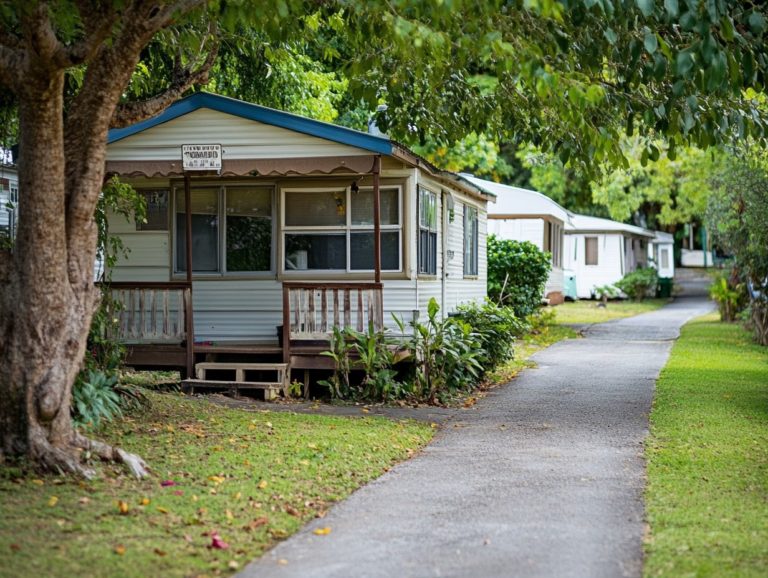Understanding the Implications of Coverage Gaps
In today s intricate insurance landscape, grasping the nuances of coverage gaps is crucial for safeguarding your assets and financial well-being. These gaps can result in unforeseen costs and legal complications, leaving you exposed when you need support the most.
This article will define coverage gaps, delve into common types, and outline the potential repercussions you might face. It will also provide practical tips on identifying and addressing these gaps, ensuring you are thoroughly covered.
Understanding your coverage gaps today can protect your financial future tomorrow!
Contents
Key Takeaways:

- Coverage gaps can lead to serious financial and legal troubles.
- Review your policies regularly and consider professional advice to stay protected.
- Take proactive steps to avoid and address coverage gaps before they become costly issues.
What are Coverage Gaps?
Coverage gaps in health insurance highlight critical disparities in access to essential health care services, impacting marginalized communities, including people of color and low-income adults. These gaps often stem from factors like rules that limit who can get Medicaid and socioeconomic barriers that impede access to adequate health care coverage.
Recognizing and understanding these coverage gaps is vital for promoting health equity and addressing the needs of the uninsured. It also sheds light on the broader implications for financial security and overall health outcomes, which are integral to fostering a more equitable health system.
Defining Coverage Gaps in Insurance
Coverage gaps in insurance represent a critical issue where insufficient healthcare coverage leaves individuals, especially low-income adults, without access to essential medical services. To address this, understanding the significance of coverage limits is crucial, as it often results in detrimental health outcomes.
These gaps typically arise from stringent Medicaid eligibility criteria, which frequently exclude many low-income individuals unable to meet income thresholds or employment requirements. As a result, this part of the population grapples with significant financial insecurity, often feeling compelled to forgo preventive care or vital treatments simply due to cost.
The absence of affordable coverage amplifies disparities in health equity, placing uninsured individuals at an elevated risk for deteriorating health conditions and heavier financial burdens.
Moreover, the implications of these coverage gaps extend beyond personal health, impacting society at large. They lead to increased healthcare costs for communities and place a greater strain on emergency services, highlighting the pressing need for systemic reforms.
Types of Coverage Gaps
You may encounter various types of coverage gaps, each influencing different populations. This includes the uninsured, individuals residing in non-expansion states, and those who face obstacles in accessing essential health care services. Understanding the role of coverage in risk management is crucial for addressing these issues.
Examples of Common Coverage Gaps
Common examples of coverage gaps include the absence of Medicaid expansion in certain states, leaving a significant number of uninsured individuals without access to essential health care services, particularly in maternal health.
Marginalized communities feel the brunt of this issue the most, especially Black and Latino adults, who face heightened maternal health disparities due to systemic barriers. In states that have yet to expand Medicaid, expectant mothers within these groups may experience delays in prenatal care, increasing the risk of complications during pregnancy and childbirth.
The financial burden of out-of-pocket costs often deters them from seeking the medical attention they need, leading to negative health outcomes.
Ultimately, this gap not only perpetuates health inequalities but also places a strain on personal finances and the broader healthcare system, underscoring the urgent need for comprehensive coverage solutions.
The Impact of Coverage Gaps

The effects of coverage gaps reach far beyond personal financial troubles. They create barriers to accessing care, intensify medical debt, and ultimately lead to poorer health outcomes for vulnerable populations.
Financial Consequences
The financial effects of coverage gaps can be severe, particularly for uninsured low-income adults. These individuals often struggle with overwhelming medical debt and limited access to essential health insurance.
You may find yourself in a precarious situation where even minor health issues can spiral into crippling costs. Recent studies reveal that nearly 31% of uninsured adults report accumulating medical debt. This forces many to make heartbreaking choices between basic necessities like food and shelter, or paying for urgent medical care.
This financial strain hampers your ability to seek timely treatment and worsens existing health conditions. The correlation between high medical debt and poor health outcomes is striking. Those burdened by such debt are less likely to pursue preventive care or effectively manage chronic conditions. This ultimately results in higher rates of illness and death among uninsured populations.
Legal Implications
The legal issues around coverage gaps are complex and relate to Medicaid expansion, state policies, and unequal access to healthcare among various socioeconomic groups.
These complexities become more pronounced with the differing decisions states make about adopting Medicaid expansion under the Affordable Care Act (ACA). Medicaid, a government program, helps low-income individuals access healthcare. States that opt to expand Medicaid generally witness enhanced health outcomes for low-income residents. Meanwhile, those that decline often create significant coverage gaps, deepening existing disparities.
As you navigate the complex web of state legislation, it’s clear that the political climate plays a crucial role in shaping decisions regarding healthcare access. This legal landscape impacts not only the quality of care available to individuals but also the overall equity of the healthcare system.
How to Identify Coverage Gaps
Identifying coverage gaps requires a thorough examination of insurance policies, a solid understanding of Medicaid eligibility criteria, and the strategic use of community resources to ensure equitable access to care.
Reviewing Insurance Policies
Reviewing your insurance policies is an essential step in identifying coverage gaps. It allows you to understand both the benefits and limitations that impact your health equity and financial security.
By systematically examining each component of your policy, you can pinpoint areas where your coverage might fall short. Pay particular attention to:
- deductibles
- co-pays
- exclusions
- provider networks
It’s equally important to assess the types of services covered, especially in critical areas like preventive care and mental health. These can easily slip under the radar. Consider your evolving needs whether it s family planning or managing chronic conditions to ensure your policy adapts alongside your life circumstances.
This thorough review enables you to make informed decisions, optimizing your coverage for maximum peace of mind.
Seeking Professional Advice

Seeking professional advice can offer you invaluable insights to identify coverage gaps. This ensures you can access the right healthcare and community resources to support your financial security.
Engaging with healthcare professionals, insurance agents, and community organizations is more than just filling out forms. It helps you gain a deeper understanding of your unique health needs and financial situation. These experts possess the knowledge and tools needed to navigate the complex world of insurance options, ensuring you aren’t left vulnerable.
By actively consulting these resources, you can discover hidden gaps in your coverage that might otherwise slip under the radar. This guidance leads to tailored solutions that improve both your access to care and affordability, enabling you to make informed decisions that protect your well-being.
Preventing and Addressing Coverage Gaps
Preventing and addressing coverage gaps is essential for fostering health equity. This ensures that individuals can access the care they require through available community resources and well-designed training programs.
Prioritizing these efforts contributes to a system that effectively supports everyone s health needs.
Tips for Avoiding Coverage Gaps
To avoid coverage gaps, explore a variety of insurance options and stay informed about programs that ensure fair access to health care. Utilize community resources to enhance your access to care.
Actively research the different insurance plans available in your area. This will help you understand which coverage best suits your needs.
Understanding Medicaid expansion can unlock vital healthcare opportunities, particularly for those with limited income.
Participating in local workshops or informational sessions hosted by community organizations offers invaluable insights. These sessions can help you navigate the often complex world of health insurance.
By leveraging these resources, you deepen your understanding of available options and enable yourself to make informed decisions about your healthcare, ensuring that you don t slip through the cracks.
Steps to Take if a Coverage Gap is Identified
If you discover a coverage gap, it is crucial to take proactive steps. Explore community resources and reassess your Medicaid eligibility to enhance your access to essential health care.
Contact local organizations that specialize in health advocacy today for guidance on available programs tailored to your needs.
Evaluate your current insurance plans for potential enrollment in alternative options, such as short-term or subsidized insurance. This can significantly help in bridging that gap.
Engaging with state health departments is also beneficial. This allows you to understand eligibility criteria and advocate for expanded benefits.
By staying informed and connected with these resources, you enable yourself to secure the health care services you require and truly deserve.
Frequently Asked Questions
Below are some common questions about coverage gaps and how to navigate them.
What are coverage gaps?

Coverage gaps refer to times when an individual does not have health insurance coverage, either due to losing their current coverage or not having any coverage at all. It’s important to recognize these gaps and consider the need for additional coverage to protect yourself effectively.
What are the implications of coverage gaps?
Coverage gaps can have serious financial and health consequences. Without insurance coverage, individuals may face high medical bills and be unable to afford necessary healthcare services.
How do coverage gaps occur?
Coverage gaps can occur for various reasons, such as losing a job, aging out of a parent’s insurance plan, or not being able to afford insurance premiums. They can also arise from gaps in coverage for specific services, such as dental or vision care.
Can coverage gaps affect my ability to get insurance in the future?
Yes, coverage gaps can impact your ability to obtain insurance in the future. Insurance companies may consider gaps in coverage when determining premiums or may deny coverage altogether for pre-existing conditions that developed during the gap.
What steps can I take to avoid coverage gaps?
To avoid coverage gaps, regularly review and update your insurance coverage. This includes enrolling in a new plan if you lose your current coverage, purchasing short-term coverage during transition periods, or exploring options for affordable insurance plans.
There are various resources to help individuals understand and navigate coverage gaps. These include speaking with a healthcare navigator or counselor, reaching out to state healthcare agencies, or utilizing online tools and resources offered by insurance companies.






